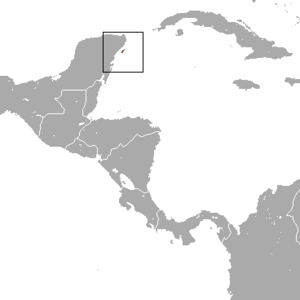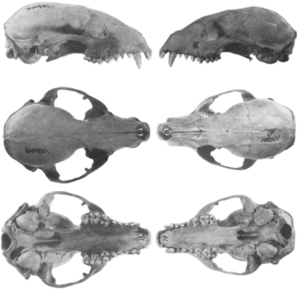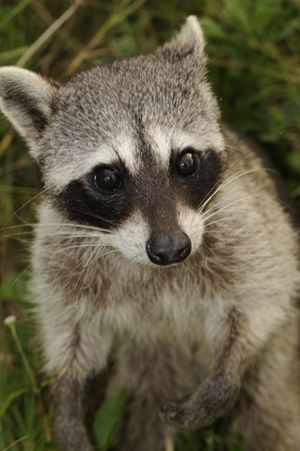Cozumel raccoon facts for kids
Quick facts for kids Cozumel raccoon |
|
|---|---|
 |
|
| Conservation status | |
| Scientific classification | |
| Genus: |
Procyon
|
| Species: |
pygmaeus
|
 |
|
| Cozumel raccoon range | |
The Cozumel raccoon (Procyon pygmaeus) is a special type of island raccoon. It is only found on Cozumel Island off the coast of Mexico. This animal is critically endangered, meaning it is in great danger of disappearing forever. People also call it the pygmy raccoon or dwarf raccoon because it is smaller than other raccoons.
Contents
What Makes the Cozumel Raccoon Special?
A scientist named Clinton Hart Merriam first described the Cozumel raccoon in 1901. He noticed it looked different from the common raccoons found on the mainland. Other scientists have agreed that it is a unique species. This means the Cozumel raccoon is considered its own distinct type of raccoon.
Scientists believe the Cozumel raccoon has lived on the island for a very long time. Cozumel Island separated from the mainland over 122,000 years ago. Studies suggest this raccoon species might have become different from common raccoons between 26,000 and 69,000 years ago.
How to Identify a Cozumel Raccoon

The Cozumel raccoon is much smaller than the common raccoon. It also has a more rounded snout. Its fur is mostly buff-grey with some black hairs. Its belly and legs are a pale buff color.
The top of its head is grey, which is different from the white fur on its muzzle and chin. It has a black "mask" pattern around its eyes, just like other raccoons. A brownish-grey line runs down the middle of its snout. Its tail is yellowish with six or seven black or brown rings. Male raccoons sometimes have a patch of bright orange fur on their neck.
Adult Cozumel raccoons are about 58 to 82 centimeters (23 to 32 inches) long, including their tail. They weigh between 3 and 4 kilograms (6.6 to 8.8 pounds). This small size is an example of insular dwarfism. This means animals on islands sometimes evolve to be smaller than their relatives on the mainland. Males are usually about 20% heavier than females.
Where Do Cozumel Raccoons Live?
The Cozumel raccoon is only found on Cozumel Island. This island is about 478 square kilometers (185 square miles) in size. It is located off the east coast of the Yucatan Peninsula in Mexico.
These raccoons are critically endangered because they live in such a small area. Scientists estimate there are only about 250 to 300 individuals left.
On the island, Cozumel raccoons prefer to live in mangrove forests and sandy wetlands. These areas are mostly found in the northwest part of the island. However, they can also be found in other places like semi-evergreen forests and farms. They have even been seen in the Punta Sur ecological park.
Cozumel Raccoon Behavior
Cozumel raccoons are mostly active at night. They are usually solitary animals, meaning they live alone. However, a mother raccoon might stay with her cubs in a family group.
These raccoons live in densities of about 17 to 27 individuals per square kilometer. Each raccoon uses an area of about 67 hectares (166 acres) as its home range. They do not seem to defend their territories very strongly.
Scientists don't know much about their breeding habits. However, females seem to give birth mostly between November and January. They might also have a second litter during the summer months.
What Do Cozumel Raccoons Eat?
Cozumel raccoons are omnivores, meaning they eat both plants and animals. Their diet includes crabs, fruit, frogs, lizards, and insects. Crabs make up more than half of what they eat. This is why they often stay near water where crabs are plentiful.
Their diet changes with the seasons. During the wet season, they eat more fruit and plants because these foods are easier to find. In the dry season, they eat more crabs, insects, and lizards.
Protecting the Cozumel Raccoon
Island animals, especially carnivores at the top of the food chain, are often at risk when humans arrive. The biggest threat to the Cozumel raccoon is the growth of tourism on Cozumel Island. The raccoons live in a small coastal area that is being developed for hotels and other tourist attractions. This means they are losing their homes. There are currently no laws specifically protecting these raccoons or their land.
Newer threats include diseases and parasites. There are many stray cats and dogs on Cozumel Island. These pets can carry diseases that can spread to the raccoons. Some raccoons have already developed antibodies to certain diseases.
What Can Be Done to Help?
One important way to help is to protect the mangrove forests. This means stopping new buildings and development in the northwest part of the island. Setting aside protected land for the raccoons would save their crucial habitat.
Another idea is to try captive breeding. If Cozumel raccoons can reproduce well in zoos, it could help increase their numbers. Also, controlling the population of stray cats and dogs on the island would reduce the spread of diseases. For any conservation efforts to work, people involved in tourism and conservation need to work together to save these unique animals.
Scientists also continue to study the Cozumel raccoon. They want to make sure it is truly a distinct species from its mainland relatives.
See also
 In Spanish: Mapache de Cozumel para niños
In Spanish: Mapache de Cozumel para niños



